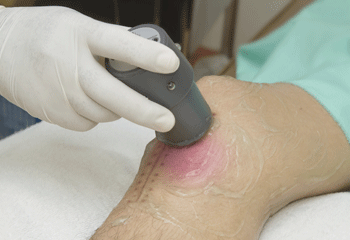Using Ultrasound to Boost Wound Healing
July 24, 2015
Researchers have developed a new handheld ultrasound device that could reportedly accelerate the healing process in skin wounds.
|
The ultrasound device in use (Image courtesy of Sheffield University) |
Kristopher Sturgis
Scientists from Sheffield University say their low-intensity ultrasound device can reduce the healing time of skin ulcers and bedsores by as much as 30%, according to a university news release.
The handheld device was developed by Mark Bass, a PhD in biochemistry at the British university, along with several other colleagues. Bass and his team found that ultrasound technologies transmit a vibration through the skin, waking up the cells inside the wound site which can stimulate and accelerate the healing process. The discovery falls in line with several other efforts over the last few years that look to enhance the healing process, including a study that worked with a nanoparticle platform that researchers found could also accelerate the healing process.
However this technology could set itself apart because it involves a handheld device that could be used to treat patients who suffer from painful skin wounds, particularly diabetic and elderly patients. Skin ulcers occur frequently in patients suffering from diabetes, and can not only be painful, but can escalate to the point of requiring amputation--something that could be avoided with this new handy device that could cut a third of the healing time off.
The key to its development actually sprung from the idea of fooling damaged cells into believing they are at a much earlier stage in the body's life cycle than they actually are. It's been known for some time that humans possess much higher regenerative capabilities earlier in life. In fact, the human body actually possesses the capability of perfect scar-free healing while still in the womb--a notion Bass and his team kept in mind when trying to manipulate the damaged cells at the site of a wound.
The group found that when they subjected the wounded area to nano-vibrations, they would cause channels to open within the cellular membrane of the surrounding skin cells, allowing calcium to flow across the membrane. This calcium plays a key role in many of the signalling mechanisms within the cell, which in turn endows the cell with a new front-back orientation. This new orientation causes the cells to move toward the damaged site, effectively pulling the edges of the wound together much like sutures would.
Of course, accelerated wound healing isn't the only progress being made in the realm of regenerative medicine. Just last year scientists at the University of Edinburgh were able to successfully grow a fully functioning organ from transplanted lab-created cells in a living animal. While growing organs in a controlled environment had been done previously, this marked the first occasion that such a feat was accomplished inside a living mammal.
The common denominator is that regenerative medicine and enhanced healing technologies are quickly rising to the fore, as researchers look to push the boundaries of treatment to new heights.
Bass noted that it is possible to enhance the effects of this ultrasound technology even further with continued refinement of the device and how it is used. Most notably, because ultrasound is relatively risk free, he believes we could see such a device in broad clinical use within the next three or four years.
Refresh your medical device industry knowledge at MEDevice San Diego, September 1-2, 2015. |
Kristopher Sturgis is a contributor to Qmed and MPMN.
Like what you're reading? Subscribe to our daily e-newsletter.
About the Author(s)
You May Also Like



